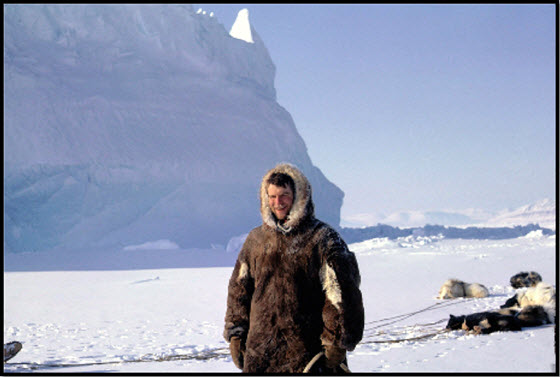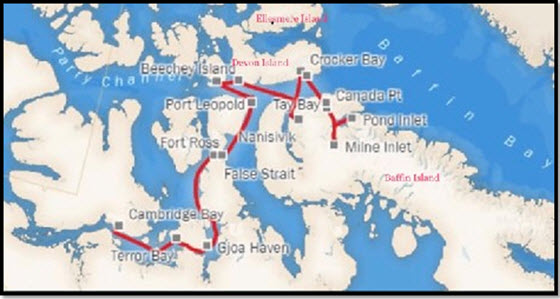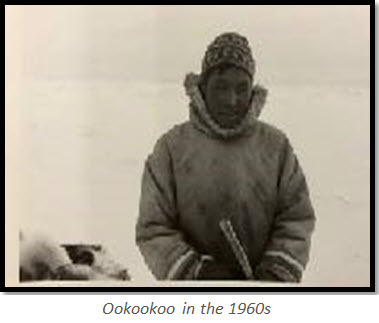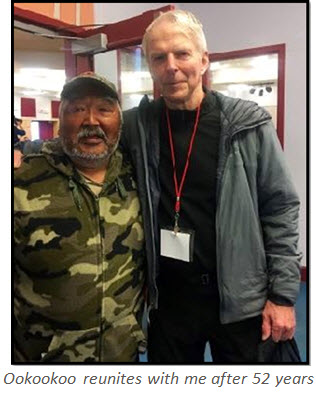Retired judge Tom Smith shares the story of his return to the Arctic in an icebreaker five decades after serving there as a young constable, and what he found.
“For the three years I served as an RCMP constable at Alexandra Fiord and Grise Fiord on Ellesmere Island, in the early 1960s, we never opened a criminal file—we ran a trading store with the Inuit, pulled teeth, stitched cuts, removed a placenta, and ran the post office—mail was sometimes over a year old. With the Inuit, I explored thousands of miles by dog team. The Inuit there spoke no English so I learned enough Inuktitut to get along.

S/Cst. Ningyoo took this photo of me about 1963 with an iceberg to the left, South Ellesmere Island in the background, and my RCMP dog team to the right. I am wearing caribou clothing.
In March this year Dick Ford, a friend, called me and urged me to apply to join the Canada C3
Expedition that he just learned about on CBC. I followed his advice and luckily C3 selected me as a participant on Leg 9—a two-week sail by icebreaker through the Northwest Passage from Pond Inlet, north Baffin Island, to Cambridge Bay in the central arctic. The Canada C3
Expedition, a Signature Project for Canada’s 150th Anniversary, was a 150-day sailing journey by the Polar Prince, an icebreaker, from Toronto to Victoria via the Northwest Passage. You can read and see videos and photos about the Expedition at canadac3.ca.

Map of Leg 9, Canada C3 Expedition
In mid August at Pond Inlet on north Baffin Island, where Leg 9 started, and 52 years after I left Grise Fiord on Ellesmere, people at Pond Inlet gathered at a community hall for the announcement of the Lancaster Sound National Marine Conservation Area, an area twice the size of Nova Scotia, where 75 percent of the world’s narwals summer.

When I arrived at the hall, before most people, I asked an Inuk woman about Ookookoo, a teenager and respected hunter when I lived at Grise Fiord, Ellesmere Island.
Ookookoo soon appeared. I didn't recognize him but we hugged and soon tears welled up in his eyes and then in mine. I remember him telling me that a polar bear charged him, tore his parka, knocked him down, and then left. Since then he has travelled three times by snowmobile to the north pole.
His spouse, Hannah, was with him—she was a teenager when we last saw one another—and held up her finger and said, "You stitched my finger." I held up my thumb and said, "And I stitched my own thumb too.”
Soon children of people I knew on Ellesmere appeared and also grandchildren and a greatgrandchild. I showed them photos I had taken in the 1960s and realized how deep our roots were and how I need to write about my experiences and share my photos from those magical times. Our visits were too short —I left Pond Inlet with my heart aching.

When I left for the trip our home was threatened by the forest fires that raged in BC this past summer. Midge, my wife, encouraged me to go on the trip —and I did—with the following words placing things in perspective, taken from an Inuk in the early 1920s on Kent Peninsula near Cambridge Bay where Leg 9 of the C3 trip ended:
The One Great Thing
And I think over again
My small adventures
When from a shore wind
I drifted out
In my kayak
And I thought I was in danger.
My fears,
Those small ones
That I thought so big,
For all the vital things I had to get and to reach.
And yet, there is only
One great thing,
The only thing.
To live and see in huts and on journeys
The great day that dawns,
And the light that fills the world.
Collected and translated by Knud Rasmussen on the Kent Peninsula, from The Report of the Fifth Thule Expedition, 1921–1924. From: Stephen Bown, White Eskimo, Knud Rasmussen's fearless journey into the heart of the arctic, Douglas and McIntyre (2013) Ltd. “

